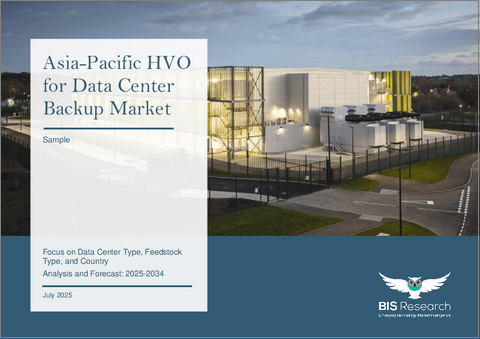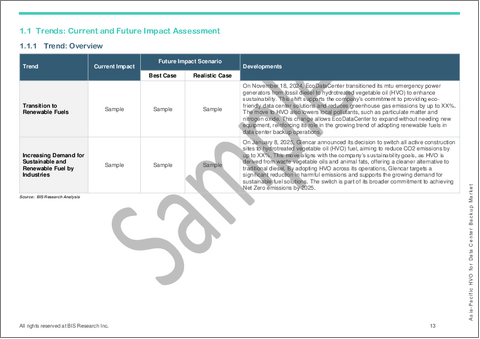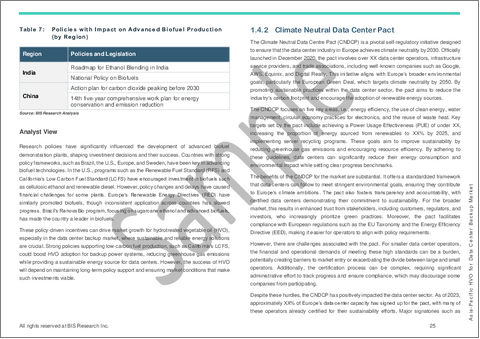|
|
市場調査レポート
商品コード
1776229
アジア太平洋のデータセンターバックアップ用HVO市場:データセンタータイプ別、原料タイプ別、国別 - 分析と予測(2025年~2034年)Asia-Pacific HVO for Data Center Backup Market: Focus on Data Center Type, Feedstock Type, and Country - Analysis and Forecast, 2025-2034 |
||||||
カスタマイズ可能
|
|||||||
| アジア太平洋のデータセンターバックアップ用HVO市場:データセンタータイプ別、原料タイプ別、国別 - 分析と予測(2025年~2034年) |
|
出版日: 2025年07月25日
発行: BIS Research
ページ情報: 英文 70 Pages
納期: 1~5営業日
|
全表示
- 概要
- 図表
- 目次
アジア太平洋のデータセンターバックアップ用HVOの市場規模は、2024年に11万2,100米ドルとなりました。
同市場は、10.17%のCAGRで拡大し、2034年には35万9,500米ドルに達すると予測されています。データセンターのバックアップ燃料としての水素化分解植物油(HVO)市場は、事業者がドロップインの低炭素ディーゼル代替燃料を探しているため、アジアで急速に拡大しています。HVOは、ライフサイクルのCO2排出量を最大90%削減すると同時に、デジタル・トランスフォーメーションによって増大するアップタイム・ニーズに対応する信頼性の高いバックアップ・パワーを提供します。燃料の安定性、貯蔵寿命、発電機の性能は、HVO生産の進歩と、オンサイト太陽光発電、蓄電池、マイクログリッドシステムとのスムーズな統合によって改善されています。各国のバイオ燃料法、税制優遇措置、脱炭素化要件に後押しされ、Neste、TotalEnergies、Repsol、Shellなどの国際的プロバイダーが、シンガポール、日本、オーストラリア、インドで事業を拡大しています。APACのデータセンター事業者は、規制圧力の高まりと企業の持続可能性基準の厳格化に伴い、より環境に優しいデジタル・インフラへの移行を推進するため、手頃な価格で拡張性があり、排出量に見合ったバックアップ・ソリューションを求めてHVOを利用するようになっています。
| 主要市場統計 | |
|---|---|
| 予測期間 | 2025年~2034年 |
| 2025年の評価 | 15万400米ドル |
| 2034年の予測 | 35万9,500米ドル |
| CAGR | 10.17% |
市場イントロダクション
アジア太平洋が脱炭素デジタルインフラを目指している中、データセンター電源システムのバックアップ燃料としての水素化分解植物油(HVO)市場の重要性が高まっています。HVOは、ほぼ同じ性能特性を持ち、ライフサイクル温室効果ガス排出量を最大90%削減できるため、データセンター事業者が、ますます厳しくなる排出目標や、増大する送電網の不安定化リスクと闘う中で、従来のディーゼル発電機に代わるドロップイン再生可能燃料として台頭してきました。原料処理の迅速な開発と、ハイブリッド・エネルギー・システム(スマート・マイクログリッド、オンサイト・ソーラー、蓄電池など)へのスムーズな組み込みにより、燃料の安定性が向上し、貯蔵寿命が延び、メンテナンス・スケジュールが短縮されています。
Neste、TotalEnergies、Repsol、Shellは、シンガポール、日本、オーストラリア、インドといったAPACの主要拠点で、HVO専門の生産能力を拡大しています。バイオ燃料の混合義務化、再生可能燃料に対する税制優遇措置、プロジェクトの経済性を高める優遇融資制度などが、投資の基盤となっています。一方、ハイパースケールデータセンターやエンタープライズデータセンターのオーナーは、弾力性の利点とカーボンクレジットの見込みを検証するため、HVOをパイロットシステムや商用バックアップシステムに徐々に組み込んでいます。
アジア太平洋のデータセンターバックアップ用HVO市場は、企業の持続可能性への誓約、規制要件、エネルギー・セキュリティへの懸念の変化が重なり、急成長が見込まれています。この変化は、緊急の継続ニーズを満たすだけでなく、アジア太平洋地域全体で、より強靭で環境に優しいデジタル経済を構築するという長期的な目標をサポートするものです。
市場セグメンテーション
セグメンテーション1:データセンタータイプ別
- コロケーションとリテール
- ハイパースケールデータセンター
- その他
セグメント2:データセンタータイプ別
- 食用植物油
- 粗パーム油
- 使用済み食用油
- トール油
- 動物油脂
- その他
- 非食用植物油
- パーム油工場廃液
- その他
セグメンテーション3:地域別
- アジア太平洋
アジア太平洋のデータセンターバックアップ用HVO市場動向と促進要因・課題
動向
- 低炭素バックアップ・ソリューションへのシフト:アジア太平洋の主要データセンター事業者は、企業のネットゼロ目標に合わせ、従来のディーゼル発電機に代わるよりクリーンな代替手段として、水素化分解植物油(HVO)を試験的に導入しています。
- ハイブリッド電源アーキテクチャとの統合:HVOシステムは、全体的なバックアップ容量を最適化し、発電機の運転時間を短縮するために、バッテリーエネルギー貯蔵やオンサイト再生可能エネルギーとの組み合わせが増加しています。
- 戦略的パートナーシップとパイロット・プロジェクト:技術プロバイダー、燃料サプライヤー、およびハイパースケールデータセンター事業者は、特にシンガポール、日本、およびオーストラリアで、性能、排出量、およびコストの測定基準を検証するためのパイロット導入に協力しています。
- 政府と規制の後押し:アジア太平洋のいくつかの政府(例:日本のグリーン成長戦略、インドの国家バイオ燃料政策)は、バイオ燃料を利用したバックアップ発電にインセンティブを与えたり、承認を簡素化したりしています。
促進要因
- 排出削減義務:温室効果ガスや粒子状物質の排出に関する地域ごとの目標が強化されているため、データセンターは規制に準拠したバックアップ燃料を求める傾向にあります。
- 企業の持続可能性へのコミットメント:主要な世界クラウドプロバイダーは、2030年までに24時間365日カーボンフリーの運用を約束しており、HVOはよりクリーンなバックアップ電源への即座のドロップインルートを提供します。
- 送電網の信頼性への懸念:新興国市場(東南アジア、インドなど)では、頻繁に送電網の停止や電圧変動が発生するため、事業継続性を維持する堅牢で長時間のバックアップソリューションに対する需要が高まっています。
- ライフサイクルコストの優位性:HVOはディーゼルよりも若干割高ですが、(よりクリーンな燃焼特性別)メンテナンスの必要性の低さや、潜在的なカーボンクレジットにより、総所有コストを相殺することができます。
課題
- 原料供給の制約:食用作物や土地利用に影響を与えることなく、HVO生産を持続的に拡大することがボトルネックとなっています。他産業との原料競合が価格を押し上げる可能性があります。
- 燃料インフラのアップグレード:HVOを大規模に安全に使用するためには、既存のディーゼル貯蔵・ハンドリング・システムの改修(マテリアル適合性チェック、ろ過強化など)が必要となる場合があります。
- 価格変動とプレミアム:HVOは現在、超低硫黄ディーゼルに比べて10~30%のプレミアムで取引されており、コスト重視の事業者にとって予算承認がより複雑になります。
- 規制と認証のハードル:バイオ燃料混合と発電機の認証に関するアジア太平洋の統一基準がないため、複数の国での展開が遅れる可能性があります。
製品/イノベーション戦略:製品タイプは、地域ごとに利用可能な製品の種類を理解するのに役立ちます。また、アジア太平洋のデータセンターバックアップ用HVO市場を用途や製品別に詳細に把握することができます。
成長/マーケティング戦略:アジア太平洋のデータセンターバックアップ用HVO市場は、事業拡大、パートナーシップ、コラボレーション、ジョイントベンチャーなど、市場で事業を展開する主要企業による主要な開拓が見られます。アジア太平洋のデータセンターバックアップ用HVO市場における地位を強化するため、各社は相乗効果を狙った戦略をとっています。
当レポートでは、アジア太平洋のデータセンターバックアップ用HVO市場について調査し、市場の概要とともに、データセンタータイプ別、原料タイプ別、国別の動向、および市場に参入する企業のプロファイルなどを提供しています。
目次
エグゼクティブサマリー
第1章 市場
- 動向:現状と将来への影響評価
- トレンド:概要
- 再生可能燃料への移行
- 持続可能かつ再生可能な燃料に対する産業界の需要増加
- HVOサプライチェーンの概要
- バリューチェーン分析
- 価格予測
- 水素化処理植物油と他の持続可能な燃料との比較
- 水素化植物油の将来の原料
- 生産能力分析
- 水素化処理植物油の需給分析
- 研究開発レビュー
- 特許出願動向(企業別)
- 規制状況と業界の取り組み
- ステークホルダー分析
- 市場力学の概要
- 市場促進要因
- 市場抑制要因
- 市場機会
- データセンター電源バックアップ市場概要
- ディーゼル発電機の代替品
- 市場導入シナリオ
- 新しい発電機の導入
- 既存システムの変換
- バックアップにHVOを採用するデータセンター
- STT GDC Pte Ltd
第2章 地域
- 地域のサマリー
- アジア太平洋
- 地域概要
- 市場成長促進要因
- 市場成長抑制要因
- 用途
- 製品
- 中国
- 日本
- シンガポール
- 韓国
- その他
第3章 市場-競合ベンチマーキングと企業プロファイル
- 今後の見通し
- 地理的評価
第4章 調査手法
List of Figures
- Figure 1: Asia-Pacific HVO for Data Center Backup Market Scenarios, 2024, 2029, 2034
- Figure 2: Asia-Pacific HVO for Data Center Backup Market (by Data Center Type), $Thousand, 2024, 2029, and 2034
- Figure 3: Asia-Pacific HVO for Data Center Backup Market (by Feedstock), $Thousand, 2024, 2029, and 2034
- Figure 4: HVO for Data Center Backup Market, Recent Developments
- Figure 5: HVO for Data Center Backup Market Pricing Forecast, $/Liter, 2024-2034
- Figure 6: Estimated Production Capacity of Key Producers, Tonnes/ Year
- Figure 7: Comparison of Overall Supply and Demand, 2024, Million Litres
- Figure 8: HVO for Data Center Backup Market (by Company), January 2021-December 2024
- Figure 9: Diesel Backup Gensets Comparison
- Figure 10: China HVO for Data Center Backup Market, $Thousand, 2024-2034
- Figure 11: Japan HVO for Data Center Backup Market, $Thousand, 2024-2034
- Figure 12: Singapore HVO for Data Center Backup Market, $Thousand, 2024-2034
- Figure 13: South Korea HVO for Data Center Backup Market, $Thousand, 2024-2034
- Figure 14: Rest-of-Asia-Pacific HVO for Data Center Backup Market, $Thousand, 2024-2034
- Figure 15: Strategic Initiatives, 2021-2024
- Figure 16: Share of Strategic Initiatives, 2021-2024
- Figure 17: Data Triangulation
- Figure 18: Top-Down and Bottom-Up Approach
- Figure 19: Assumptions and Limitations
List of Tables
- Table 1: Market Snapshot
- Table 2: Opportunities across Regions
- Table 3: Comparison between HVO and Biodiesel
- Table 4: Comparison between HVO and Other Sustainable Fuels
- Table 5: Difference Between HVO Biodiesel and FAME
- Table 6: Raw Materials for HVO Production
- Table 7: Policies with Impact on Advanced Biofuel Production (by Region)
- Table 8: Impact Analysis of Market Navigating Factors, 2024-2033
- Table 9: Fuel Specifications Tested by Rolls Royce plc
- Table 10: Fuel Specifications Tested by Caterpilar
- Table 12: Asia-Pacific HVO for Data Center Backup Market (by Data Center Type), $Thousand, 2024-2034
- Table 13: Asia-Pacific HVO for Data Center Backup Market (by Feedstock Type), $Thousand, 2024-2034
- Table 14: China HVO for Data Center Backup Market (by Data Center Type), $Thousand, 2024-2034
- Table 15: China HVO for Data Center Backup Market (by Feedstock Type), $Thousand, 2024-2034
- Table 16: Japan HVO for Data Center Backup Market (by Data Center Type), $Thousand, 2024-2034
- Table 17: Japan HVO for Data Center Backup Market (by Feedstock Type), $Thousand, 2024-2034
- Table 18: Singapore HVO for Data Center Backup Market (by Data Center Type), $Thousand, 2024-2034
- Table 19: Singapore HVO for Data Center Backup Market (by Feedstock Type), $Thousand, 2024-2034
- Table 20: South Korea HVO for Data Center Backup Market (by Data Center Type), $Thousand, 2024-2034
- Table 21: South Korea HVO for Data Center Backup Market (by Feedstock Type), $Thousand, 2024-2034
- Table 22: Rest-of-Asia-Pacific HVO for Data Center Backup Market (by Data Center Type), $Thousand, 2024-2034
- Table 23: Rest-of-Asia-Pacific HVO for Data Center Backup Market (by Feedstock Type), $Thousand, 2024-2034
- Table 24: Market Share, 2023
This report can be delivered in 2 working days.
Introduction to Asia-Pacific HVO for Data Center Backup Market
The Asia-Pacific HVO for data center backup market was valued at $112.1 thousand in 2024 and is projected to grow at a CAGR of 10.17%, reaching $359.5 thousand by 2034. The market for hydrotreated vegetable oil (HVO) as a data-center backup fuel is expanding quickly in Asia as operators look for drop-in, low-carbon diesel substitutes. HVO reduces lifecycle CO2 emissions by up to 90% while providing dependable backup power in the face of increasing uptime needs brought on by digital transformation. Fuel stability, storage life, and genset performance are being improved by advances in HVO production and its smooth integration with on-site solar, battery storage, and microgrid systems. With the help of national biofuel laws, tax breaks, and decarbonisation requirements, international providers like Neste, TotalEnergies, Repsol, and Shell are expanding their operations in Singapore, Japan, Australia, and India. APAC data centre operators are increasingly turning to HVO for an affordable, scalable, and emissions-aligned backup solution as regulatory pressure increases and corporate sustainability standards tighten, driving the region's transition to a greener digital infrastructure.
| KEY MARKET STATISTICS | |
|---|---|
| Forecast Period | 2025 - 2034 |
| 2025 Evaluation | $150.4 Thousand |
| 2034 Forecast | $359.5 Thousand |
| CAGR | 10.17% |
Market Introduction
The market for hydrotreated vegetable oil (HVO) as a backup fuel for data centre power systems is growing in importance as the Asia-Pacific (APAC) region strives towards decarbonised digital infrastructure. With nearly identical performance characteristics and up to 90% reductions in lifecycle greenhouse gas emissions, HVO has emerged as a drop-in renewable alternative to traditional diesel generators as data centre operators struggle with increasingly strict emissions targets and the growing risks of grid instability. Quick developments in feedstock processing, together with their smooth incorporation into hybrid energy systems (such as smart microgrids, on-site solar, and battery storage), are improving fuel stability, prolonging storage life, and lowering maintenance schedules.
Neste, TotalEnergies, Repsol, and Shell are expanding specialised HVO production capacity in key APAC hubs like Singapore, Japan, Australia, and India. Mandates for the mixing of biofuels, tax breaks for renewable fuels, and preferential financing programs that boost project economics serve as the foundation for their investments. Meanwhile, in order to validate resilience advantages and carbon-credit prospects, hyperscale and enterprise data-center owners are progressively integrating HVO into pilot and commercial backup systems.
The APAC HVO for data-center backup market is expected to grow rapidly because to the combination of corporate sustainability pledges, regulatory requirements, and changing energy-security concerns. In addition to meeting urgent continuity needs, this change supports longer-term goals of building a more resilient and environmentally friendly digital economy throughout the Asia-Pacific area.
Market Segmentation
Segmentation 1: by Data Center Type
- Colocation and Retail
- Hyperscale Data Center
- Others
Segmentation 2: by Data Center Type
- Edible Vegetable Oils
- Crude Palm Oil
- Used Cooking Oil
- Tall Oil
- Animal Fats
- Others
- Non-Edible Vegetable Oil
- Sludge Palm Oil Mill Effluent
- Others
Segmentation 3: by Region
- Asia-Pacific
APAC HVO for Data Center Backup Market Trends, Drivers and Challenges
Trends
- Shift to Low-Carbon Backup Solutions: Major data center operators in APAC are trialing and adopting hydrotreated vegetable oil (HVO) as a cleaner alternative to conventional diesel generators, aligning with corporate net-zero targets.
- Integration with Hybrid Power Architectures: HVO systems are increasingly being paired with battery energy storage and on-site renewables to optimize overall backup capacity and reduce genset runtime.
- Strategic Partnerships & Pilot Projects: Technology providers, fuel suppliers, and hyperscale data center operators are collaborating on pilot deployments-particularly in Singapore, Japan, and Australia-to validate performance, emissions, and cost metrics.
- Government & Regulatory Encouragement: Several APAC governments (e.g., Japan's Green Growth Strategy, India's National Biofuel Policy) are offering incentives or streamlined approvals for biofuel-powered backup generation.
Drivers
- Emissions Reduction Mandates: Tightening regional targets for greenhouse gas and particulate emissions are pushing data centers to seek compliant backup fuels.
- Corporate Sustainability Commitments: With major global cloud providers pledging 24/7 carbon-free operations by 2030, HVO offers an immediate drop-in route to cleaner backup power.
- Grid Reliability Concerns: Frequent grid outages or voltage fluctuations in developing APAC markets (e.g., Southeast Asia, India) drive demand for robust, long-duration backup solutions that maintain business continuity.
- Lifecycle Cost Advantages: Although HVO carries a slight price premium over diesel, lower maintenance requirements (due to its cleaner combustion profile) and potential carbon credits can offset total cost of ownership.
Challenges
- Feedstock Supply Constraints: Scaling HVO production sustainably-without impacting food crops or land use-remains a bottleneck. Feedstock competition with other industries can drive up prices.
- Fuel Infrastructure Upgrades: Existing diesel storage and handling systems may require modifications (e.g., material compatibility checks, filtration enhancements) before HVO can be used safely at scale.
- Price Volatility & Premium: HVO currently trades at a 10-30% premium over ultra-low-sulfur diesel, making budget approvals more complex for cost-focused operators.
- Regulatory & Certification Hurdles: Lack of unified APAC standards for biofuel blending and generator certification can slow roll-out across multiple countries.
How can this report add value to an organization?
Product/Innovation Strategy: The product segment helps the reader understand the different types of products available regionally. Moreover, the study provides the reader with a detailed understanding of the APAC HVO for data center backup market based on application and product.
Growth/Marketing Strategy: The APAC HVO for data center backup market has seen major development by key players operating in the market, such as business expansion, partnership, collaboration, and joint venture. The favored strategy for the companies has been synergistic activities to strengthen their position in the APACHVO for data center backup market.
Competitive Strategy: Key players in the APAC HVO for data center backup market have been analyzed and profiled in the study of HVO for data center backup products. Moreover, a detailed competitive benchmarking of the players operating in the APACHVO for data center backup market has been done to help the reader understand how players stack against each other, presenting a clear market landscape. Additionally, comprehensive competitive strategies such as partnerships, agreements, and collaborations will aid the reader in understanding the untapped revenue pockets in the market.
Table of Contents
Executive Summary
Scope and Definition
1 Markets
- 1.1 Trends: Current and Future Impact Assessment
- 1.1.1 Trend: Overview
- 1.1.2 Transition to Renewable Fuels
- 1.1.3 Increasing Demand for Sustainable and Renewable Fuel by Industries
- 1.2 HVO Supply Chain Overview
- 1.2.1 Value Chain Analysis
- 1.2.2 Pricing Forecast
- 1.2.3 Comparison between Hydrotreated Vegetable Oil and Other Sustainable Fuels
- 1.2.4 Future Raw Materials for Hydrotreated Vegetable Oil
- 1.2.5 Production Capacity Analysis
- 1.2.6 Supply and Demand Analysis for Hydrotreated Vegetable Oil
- 1.3 Research and Development Review
- 1.3.1 Patent Filing Trend (by Company)
- 1.4 Regulatory Landscape and Industry Initiatives
- 1.4.1 Regulations and Policies
- 1.4.2 Climate Neutral Data Center Pact
- 1.4.3 Others
- 1.5 Stakeholder Analysis
- 1.5.1 End User and Buying Criteria
- 1.6 Market Dynamics Overview
- 1.6.1 Market Drivers
- 1.6.1.1 Carbon Emission Reduction Goals
- 1.6.1.2 Growth of Power Demand by Data Centers
- 1.6.2 Market Restraints
- 1.6.2.1 Infrastructure and Compatibility Costs
- 1.6.2.2 Supply Chain Limitations
- 1.6.3 Market Opportunities
- 1.6.3.1 Regulatory Support and Incentives
- 1.6.3.2 Partnerships and Collaborations with Biofuel Producers
- 1.6.1 Market Drivers
- 1.7 Data Center Power Backup Market Overview
- 1.7.1 Alternatives to Disel Gensets
- 1.8 Market Adoption Scenario
- 1.8.1 Adoption of New Generators
- 1.8.2 Conversion of Existing Systems
- 1.9 Data Centers Adopting HVO for Backup
- 1.9.1 STT GDC Pte Ltd
- 1.9.1.1 Locations
- 1.9.1.2 Long Term Plan
- 1.9.1 STT GDC Pte Ltd
2 Regions
- 2.1 Regional Summary
- 2.2 Asia-Pacific
- 2.2.1 Regional Overview
- 2.2.2 Driving Factors for Market Growth
- 2.2.3 Factors Challenging the Market
- 2.2.4 Application
- 2.2.5 Product
- 2.2.6 China
- 2.2.7 Japan
- 2.2.8 Singapore
- 2.2.9 South Korea
- 2.2.10 Rest-of-Asia-Pacific
3 Markets - Competitive Benchmarking & Company Profiles
- 3.1 Next Frontiers
- 3.2 Geographic Assessment
4 Research Methodology
- 4.1 Data Sources
- 4.1.1 Primary Data Sources
- 4.1.2 Secondary Data Sources
- 4.1.3 Data Triangulation
- 4.2 Market Estimation and Forecast






